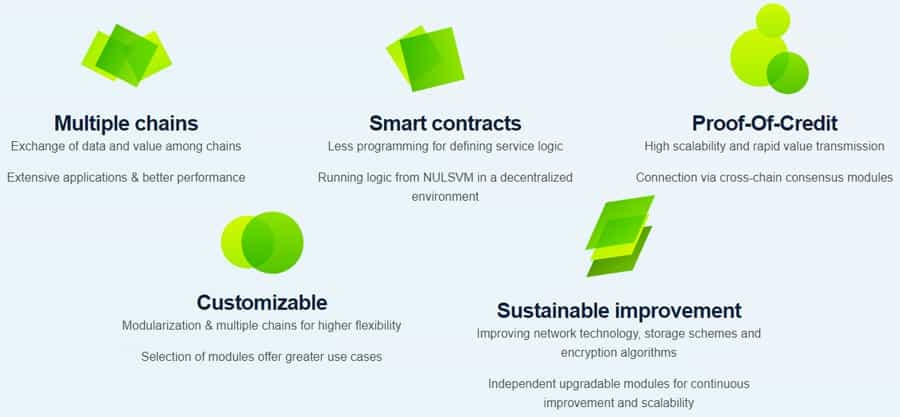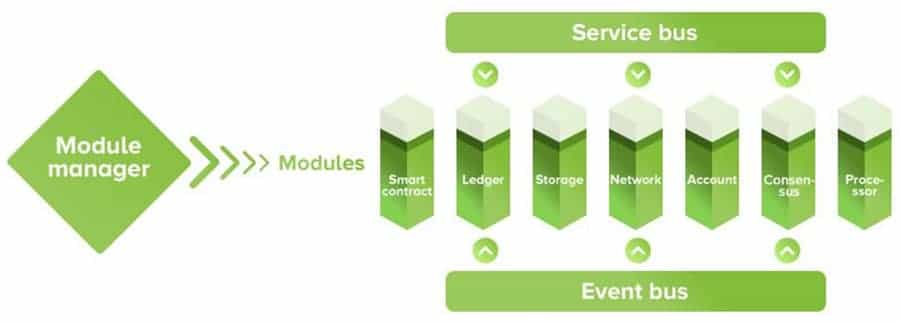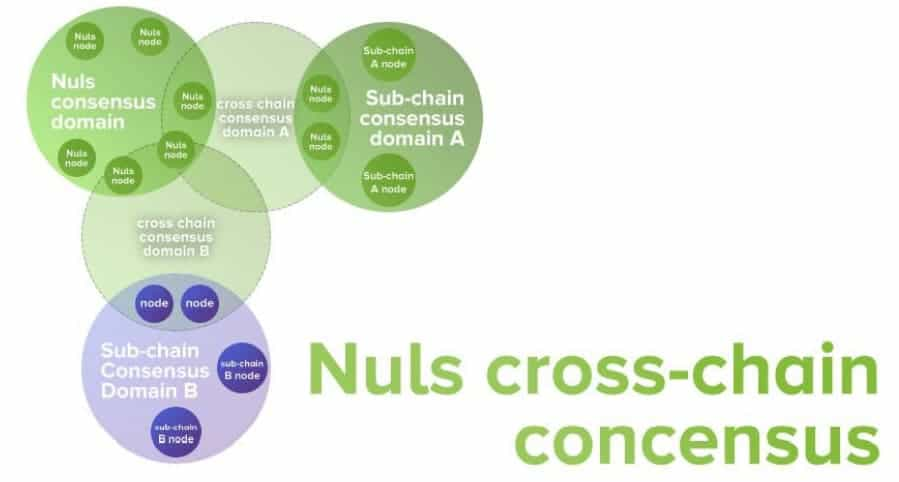Review of Nuls (NULS): Enterprise Blockchain Solutions
Nuls (NULS) is a coin that has been slowly creeping its way up the Market Cap rankings. It has suddenly generated a great deal of interest in a previously obscure cryptocurrency.
This Singaporean based project is trying to develop a highly adaptable blockchain that can be used for enterprise solutions. They have regularly used the phrase "Nuls is nothing, Nuls is everything". In other words, Nuls is not traditionally defined and can be melded into anything that the community sees fit.
However, should you consider NULS? Does the project have strong prospects or is it too loosely defined?
In this Nuls coin review we will take a deep dive on the project and give you what you need to know about the technology, team and use cases. We will also look at some of the pros and cons as well as the long term NULS token potential.
What is Nuls?
Nuls is looking to solve the problems faced by blockchains by creating one that features modularity and sub-chain operability. The two part design of functional modules and microkernels will provide both an underlying network mechanism and compartmentalized features for the blockchain.
Essentially this should provide scalability and security to the blockchain, while adhering to the programming practices of low coupling and high cohesion. And because the blockchain is designed to be modular, it becomes hot pluggable, allowing for the addition or removal of modules at any time.

This open source project will give developers flexibility through its customizable infrastructure. Nuls will include cross-chain consensus, a multi-chain mechanism and smart contract support. In addition to creating a trustless decentralized environment, Nuls also allows the users to customize the chain to fit their own needs.
The network and blockchain still use all the complex concepts of blockchain such as cryptography, consensus mechanisms, storage, and smart contracts, but it has been designed to hide these complexities so developers can focus on what they want to build rather than needing to focus on complexity.
In this way Nuls is attempting to solve real world problems while remaining simple and accessible to developers of all skill levels. Using customizable modules gives developers freedom to build without the constraints of technological complexity. Nuls is also working to promote the commercial uses of blockchain technology to help it spread more rapidly.
The Nuls Mission
There are several blockchain problems inhibiting growth and development of the industry that have been identified by the Nuls team. One such issue is the cost of development. Because there is a shortage of blockchain proficient developers, those with skills can command higher salaries.
This is simply demand exceeding supply and will eventually level out as more IT professionals learn blockchain skills. That’s when businesses will see greater adoption of the technology, and only the most trustworthy blockchains will be of interest. Nuls is working to make trustworthy solutions to business problems.
The first solution for businesses is the creation of a simple programming environment. Nuls is reducing the developers learning curve by keeping some complexity hidden from developers with less blockchain experience. At the same time, extendability has been included for the more experienced developers.

Next, Nuls has made its blockchain adaptable for a variety of application use cases. This has been done by architecting a modular design, adding a multi-chain system and including smart contracts for basic task automation.
Finally, Nuls will support the processing of millions of transactions per second through the use of parallel expansion technology. This has been enabled by the multi-chain system developed on NUls, and will effectively solve the scalability issue that has plagued the growth and acceptance of blockchain technology. Once blockchains are able to scale sufficiently businesses will be far more eager to adopt the technology for their own projects.
Nuls Economic Model
The Nuls team has avoided an ICO and the token NULS is intended to help promote the entire ecosystem. In addition to being used for transaction fees and to reward miners, it will also be used to support the future development of the project, to power sub-chain digital assets, to pay for application costs, and to support Nuls based applications. Rather than holding an ICO Nuls has been distributed in four parts.
40 million tokens, or 40% of the initial supply, were airdropped to users. Another 20% or 20 million tokens have been put aside for the development of Nuls. These tokens are unlocked at a rate of 5% or 1 million per month over the course of 20 months.

Another 20% of the tokens have been put aside for community development, with no more than 4 million of these tokens to be used per year. And finally, 20% of the tokens were set aside for business partnership development and to support high quality third party Nuls project development, with no more than 4 million tokens to be used in any year.
In addition to the initial supply of 100 million coins, there will be an additional 5 million NULS minted each year through Proof of Credit consensus. These will be used to reward miners and to secure the network.
Nuls Sub-chains
In order to create a sub-chain developers will be required to pay a predefined amount of NULS tokens. This will serve to certify that any sub-chains are in fact Nuls sub-chains and will promote a healthy Nuls ecosystem.
The amount paid for sub-chains will adjust over time based on the exchange value of NULS. This adjustment is meant to keep the cost of sub-chains reasonable and will be done by community vote.
Sub-chain Currencies and Exchange
The NULS token is meant to secure the main chain, but each sub-chain will also be able to support its own token. These sub-chain tokens are considered to be assets of NULS and are issued as IOU assets. The Nuls system will provide conversion to and from smart assets.

It is not required that a sub-chain issue a smart asset, but if it chooses to do so a certain amount of NULS will need to be paid to do so. When the smart asset is created the user will set the initial ratio of smart asset to NULS token.
At the same time two pools will be created, a smart asset pool and a NULS capital pool. Their ratio will be fixed at creation, but market values will influence the conversion over time. So, if the smart asset value rises the NULS capital pool will require more NULS to support the increased value of the smart asset.
This should result in an increasing value for NULS tokens as more and more high quality projects create sub-chains on the Nuls blockchain.
Proof of Credit (PoC) Consensus
The Nuls main blockchain uses a unique consensus mechanism known as Proof-of-Credit. The PoC consensus mechanism is modular like other elements of Nuls, and sub-chains will be able to replace core functional modules as needed. This will allow users to customize the rules for their sub-chain.
The Proof of Credit mechanism works similarly to Proof of Stake, where users will need to lock up a certain number of NULS tokens in order to run a network node. The amount required to run a node is set by community consensus, and if a user decides to stop running a node they can immediately unlock and access their NULS tokens.
The Nuls Team
The team that has created and runs Nuls has extensive blockchain experience and knowledge. Perhaps more importantly, they have a shared philosophy and purpose in creating a blockchain to increase trust and adoption of blockchain technology.
The lead developer and co-founder of Nuls is Jason Zhang, who comes to the project with more than 7 years of programming experience. Much of that was in creating security systems for dozens of banks in China. This work has given him deep familiarity with nearly all cryptographic algorithms, PKI standards, and PKCS standards.

During his time in banking security Zhang was in charge of mobile banking device security, smart card security, and Treasury payments security, while also contributing to PC banking security. He also helped in cross border payments, which was developed by a combination of 17 different Chinese banks.
A second co-founder is Lily Wang, who actually came up with the initial idea for the Nuls project. At the time she was working for Chongqing TV & Science Educational Channel, as well as at Weijingtong, which provides the Chinese community in Singapore with daily news. As a proficient strategizer and negotiator she is focused on creating channels of multilateral cooperation on a global scale. Lily works to promote the growth of the Nuls community and business partnerships to increase the global awareness and adoption of Nuls.
The final co-founder is Reaper Ran, who is currently serving as the Community Leader at Nuls. He has been a student of blockchain technology since 2013 and has developed a deep understanding of community operations during his time working with the BitShares community and as a NEO community board member. The primary goal of Reaper is to maintain and grow the Nuls community.
Nuls Price History
NULS hit an all-time high of $7.99 on January 10, 2018 as the entire crpytocurrency market was reaching its zenith. At the time the token had a market capitalization of $319 million. Since then the price has dropped all the way back to $1.13 as the entire cryptocurrency market fell throughout most of 2018. At that price its market capitalization has been cut to just $45 million.

If you’re interested in buying NULS the top exchange is Binance, where you can buy it with BTC, ETH and USDT. There’s also a small volume traded on CHAOEX and on OKEx.
For storing your NULS you can use the downloadable desktop version or a web based version.
Conclusion
Nuls is primarily focused on making blockchain more accessible for developers and businesses. It seeks to do this through its modularity and the use of sub-chains, and hopes to break the complexity associated with blockchain projects, while also solving the scalability issue that is hindering the growth of the industry.
Nuls will make trust simpler, increasing the adoption rate of blockchain technology by businesses. They will also lower the cost of entry by removing complexity and increasing the supply of developers capable of programming blockchain applications.
Taken all together, the Nuls ecosystem will benefit developers, businesses, and cryptocurrency enthusiasts by providing needed solutions and increasing usage and adoption of blockchain technology.
Disclaimer: These are the writer’s opinions and should not be considered investment advice. Readers should do their own research.
